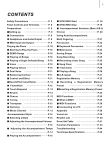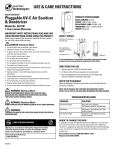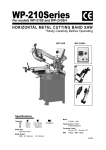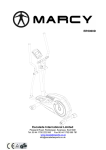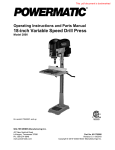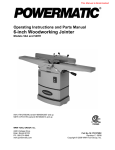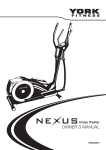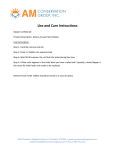Download installation/operation manual
Transcript
OPERATING SERVICE MAINTENANCE MANUAL ALL-STAR ROCKING PISTON COMPRESSOR AND VACUUM PUMP Registered by one or more of these standards agency CE ISO 9001 RoHS Compliant Read through carefully and understand these instructions before use. Contact your supplier or All-Star Products Tel 901-755-9613 www.all-star-usa.com Information Have the pump model and serial numbers when ordering parts or when contacting All-Star or your supplier. Read the Safety Rules below before working on the pump. Safety Rules Indicates an imminently hazardous situation which, if not avoided, will result in death or serious injury. ! DANGER ! Indicates a potentially hazardous WARNING situation, which, if not avoided, could result in death or serious injury. ! CAUTION situation, which, if not avoided, may Indicates a potentially hazardous result in minor or moderate injury. NOTE: This Service Manual is intended for use ONLY by a service center with properly trained and experienced repair personnel. The instructions and warnings contained herein presume existing familiarity with the design and function of this type of product and their components. The information contained in this manual is subject to change without prior notice. The manufacturer should be contacted prior performance any maintenance to determine if any changes have been made to the information contained herein, prior to performing any service or maintenance work. 1 Connection Diagram Note: The intake (suction) and the discharge piping should not be smaller than the connections in the unit. The piping can be a larger diameter. If the unit is used in a network arrangement with other pumps or compressors, the diameter of the piping should not be less than the total surface area of the total number of pumps connected in the network. VACUUM PUMP CONNECTION Capacitor Discharge Connection Inlet (Suction) & Filter COMPRESSOR CONNECTION Capacitor Discharge Connection Inlet Filter 2 COMMISSIONING ! DANGER This pump and compressor is to be used for pumping non-aggressive gasses (air) containing no more that 22% oxygen. This unit is not approved for nor should be used for explosive or toxic gasses. ! WARNING RISK OF BURNS - DO NOT TOUCH The surface temperature of the machine can reach 80 Deg C (175 Deg F) when operating at full load conditions. Wait until the unit cools down prior to performing service work. 1.0 The unit must be installed in a well-ventilated, dust-free room. The maximum ambient if 40 Deg C (104 Deg F). Intake and discharge air should be piped to limit ambient air temperature as noted above. The rocking piston pump is designed for continuous duty. The cooling fins on the unit should remain open to allow free-air circulation and the unit must be locate at least 150mm (6 inches) away from any surface. Do not allow hot air to circulate on or about the unit. STORAGE If the unit is placed into storage for a period of time greater than one (1) year, it should be stored in a dust free area subject to a maximum temperature of 40 Deg C (104 Deg F), and where it will not be subject to vibration. If stored for longer than one (1) year, the bearings should be replaced prior to start-up. 2.0 Mechanical Connections If the unit is to be connected to a network, a flexible hose should be installed to eliminate mini-vibrations from reverberating in the system piping. The connections on the unit are either .25” or .375. NPT threads. For vacuum applications, piping connections to the exhaust orifice can be made to direct the heated discharge air to an exhaust outlet. This piping should not be smaller than the connection on the unit. If a smaller discharge pipe size is used, this can result in reducing the pump speed and could overload the motor. If multiple units are installed on a network system, the exhaust pipe must equal or be greater than the coss-section of the total diameter of all of the units in the system. A drain valve at the lowest point of the exhaust line must be installed to prevent any condensation from draining back into the unit(s). Mounting of unit The unit should be mounted on an adequate mounting base using the rubber foot pads to isolate any vibration being transmitted to the mounting surface. 3 ELECTRICAL CONNECTION The power supply must be the same voltage and frequency as listed on the nameplate. The motor is a single phase, capacitor type and it has one cable connection. Connect the incoming power two conductors to the motor terminals and connect the earth (ground) wire to the earth terminal. The motor must be protected by a motor starter with a thermal overload. A circuit breaker of adequate capacity, based on the motor nameplate amperage must be used. A thermal protector is wound into the motor winding that can be use for additional temperature protection of the motor. ! 3 DANGER The motor must always be disconnected from the power supply prior to performing any maintenance on the unit. The electrical disconnect should have a lock-out feature to prevent an accidental start-up while the unit is being serviced. MAINTENANCE The points mentioned in this section are based upon the pump being applied in what can be considered a normal or standard installation. If the unit is installed or operated in any excessive condition eg, dirty environment, high temperature and so forth, the needs to be maintained frequently. Cleaning The external surface of the pump should be cleaned of any debris to allow for effective cooling of the unit. Annual Maintenance The silencer should be dismantled and cleaned or replaced if necessary. The filter cartridge should be replaced. The All-Star rocking piston pump has a designed service life of approximately 10,000 hours. Once the pump reaches this point, or approximately two (2) years, the cylinder head and casing seal needs to be replaced. This period is merely a suggestion and is dependent upon the duty cycle and environmental conditions. 10,000 Hour or Two Year Maintenance In performing this maintenance, it is recommended to perform the following: a) Replace the connecting rods or piston cups and sleeves b) Replace the flapper valves c) Replace the head O-ring head gasket d) Replace the valve plate O-rings Required tools for blower maintenance a) Torque wrench (required for head screws, connecting rod, flapper valve screws and pipe plugs b) Allen head wrench with attachments for torque wrench c) Cross-head attachment for torque wrench d) Screw driver d) Soft, clean cloth 4 Servicing the Head, Valve Plate Assembly and Connecting Rod and Bearing Assembly - Figure 1 Note: The head would only need to be replaced if it is visibly damaged. Parts Required: - Head if damaged - Head gasket - Valve plate O-ring - Complete valve plate assembly or individual flapper valves - Flapper valve screw (s) if replacing individual valve (s) Removing the Head 1. Disconnect the power to the motor 3. Disconnect all airlines and remove the unit from any enclosure 3. Remove all screws (1) that faster the head (2) to the pump housing 4. Carefully separate the head from pump body. 5. Carefully separate the valve plate assemblies (4) from the heads 6. Remove the head gasket O-rings and replace 7. Turn the valve plates over and replace the valve plate gasket O-rings FIGURE 1 5 Removing Flapper Valves Note: It is recommended that you replace one flapper valve at a time. This will help to simplify the repair process and correctly orient the flapper valves in the valve plate. 1. If you are replacing a flapper valve on the topside of he valve plate (the side facing the head), remove the flapper valve screw (1). Lift off the valve keeper strip (2), lift off the strengthen valve (3) and lift off the existing flapper valve (4). 2. Remove any debris from the valve plate with water-free alcohol (soap or other detergent should not be used due to the potential for corrosion from the soap 3. Please the valve plate on the compressor housing and orient it as illustrated. Make sure the O-ring head gasket is towards the cylinder. Note the orientation of the valve ports. 4. Orient a new flapper valve (4) over Port 1. Observe the location of the end of the flapper valve (continued on next page.) FIGURE 2 Port 2 Port 1 1 2 3 4 6 Removing Flapper Valves (continued) 5. Place a valve restraint (3) over the flapper valve 6. Place a valve keeper strip (4) over the valve restraint, observing that the restraint’s radium is facing the valve plate and oriented as shown in Figure 3. 7. Line up the screw holes in all of the valve components and fix the screw on the valve plate. 8. Make sure the flapper valve is centered over the port of the valve plate and that all of the other components line up with the flapper valve. 9. Tighten the flapper valve screw to 11.5”lbs using a torque wrench with a screw attachment. CAUTION: Do not over tighten the flapper valve screw or it will shear off in the valve plate. FIGURE 3 5 4 3 7 Replacing A Flapper Valve On The Bottom Side Of The Valve Plate 1. To replace a flapper valve on the bottom side of the valve plate (side facing the pump housing), remove the flapper valve screw (1), lift off the valve keeper strip (2). 2. Clean any debris with a soft, damp cloth. Turn the pump housing head upside down and place the valve plate on the pump head and orient it shown in Figure 4. 3. Orient a flapper valve (3) over Port 2. Observe the location of the location of the notches at the end of the flapper valve. 4. Place a valve keeper strip (4) over the flapper valve, observing that the radius of the valve plate, and oriented as shown in Figure 4. 5. Line up the screw holes in all of the valve components and fix them upon the flapper valve screw by screws. 6. Make sure the flapper valve is centered over the Port and that the valve keeper strip lines up with the flapper valve. 7. Tighten the flapper valve screw to 12.4”lbs with a torque wrench. FIGURE 4 Port 1 4 3 Port 2 2 8 1 Servicing Connecting Rod and Eccentric Assemblies Note: Refer to the Preventative Maintenance and Troubleshooting guide in this manual to determine whether a compete connecting rod assembly, or it’s component parts or an eccentric needs to be serviced. Components Required 1. Connecting rod assembly, piston cups and sleeves. 2. Valve plate gasket O-rings 3. Head gasket O-rings, if defective Removing The Connecting Rod and Eccentric Assembly Note: Only remove one connecting rod assembly at a time. 1. Carefully remove the cooling fan by pulling it straight off the pump shaft. Do not pull the motor fan blades. FIGURE 5 Cooling Fans 9 Removing The Connecting Rod And Eccentric Assemblies (cont’d) 2. Turn the motor shaft to align the eccentric setscrew, the connecting rod screw separately and with the hole of the housing. See Figure 6 for location of access hole. FIGURE 6 Eccentric screw access hole Eccentric 10 Removing The Connecting Rod And Eccentric Assemblies (cont’d) 3. Slide the eccentric bearing assembly straight off the shaft. FIGURE 7 11 Removing The Connecting Rod And Eccentric Assemblies (cont’d) 4. Slide and rotate the connecting rod, remove it from the housing. Remove the connecting rod and piston from the housing. FIGURE 8 12 Removing The Connecting Rod And Eccentric Assemblies (cont’d) 4. Slide and rotate the connecting rod, remove it from the housing. Remove the connecting rod and piston from the housing. Note: Do not damage the piston cup (4) when removing the connecting rod assembly from the pump housing. If the cup is damaged, it must be replaced. FIGURE 8 13 Rebuilding Connecting Rod Assemblies If you are rebuilding the connecting rod assembly using component parts, follow the procedure below. When replacing the piston cup (4), be sure to replace the sleeve (1) at the same time. Please the connecting rod in a fixture before attempting to remove the retainer screw. If necessary, heat will help to remove the piston cup. 1. Remove the retainer screw (2) from the cup retainer 2. Remove the retainer (3) from the connecting rod 3. Remove the cup (4) and discard 4. Place t he new piston cup (4) on the connecting rod. 5. Place the new piston cup retainer (3) on the cup connection making sure the boss of the retainer is seated in the pilot of the piston rod. 6. Insert the retainer screw (2) into the connecting rod (5) and tighten the screw with a torque wrench to 26”lbs. FIGURE 9 1 2 3 4 5 14 Assembly Of The Connecting Rod To The Pump 1. Put cylinder sleeve into the trough of housing keeper and make connecting rod vertical. Note: Connecting rod screw to face the housing. FIGURE 10 15 Assembly Of The Connecting Rod To The Pump (cont’d) 2. Replace the eccentric onto the shaft and insert bearing into connecting rod bearing housing. Rotate eccentric to line up set screw with access hole in bottom of housing. Rotate main shaft and let shaft flat and eccentric screen hole line up vertically. Tighten screw to with a torque wrench to 35 “lbs. 3. Rotate shaft with connecting rod moving up and down. The connecting rod should move freely with out any obstacle or restriction. Use Allen head wrench to tighten rod screws. FIGURE 11 Set screw access hole 16 Assembling The Pump 1. After the connecting rod assembly and the eccentric are correctly assembled, assembly of the valve plates and O-ring should be assembled next. CAUTION: To prevent damage to the pump, never apply any sealant or lubricant to the O-rings. FIGURE 12 Bottom of valve plate O-ring grove 17 Assembling The Pump (cont’d) 2. Insert the valve plate gasket O-ring into the O-ring groove located on the bottom of the valve plate. 3. Position the pump housing as shown in Figure 13. Note the orientation of the power leads. NOTE: Insure the connecting rod sleeves are seated against the pump housing. FIGURE 13 18 Assembling The Pump (cont’d) 4. Note the orientation of the valve plate assemblies. Place them on the pump housing as shown in Figure 14 FIGURE 14 Tab Valve Plate Pump Housing 19 Assembling The Pump (cont’d) 5. Insert two new head gasket O-rings into the groove located on the bottom of the head. NOTE: Insure the valve plate is properly engaged to the housing locators. NOTE: Insure that the O-rings are fully assembled in the grooves and that they are not pinched. FIGURE 15 Bottom of the head O-ring gasket 20 Assembling The Pump (cont’d) 6. Place the head on the valve plate assemblies, observing the position of the air intake and exhaust ports. NOTE: Make sure the head gasket O-rings are not pinched. 7. Insert the head screws and tighten each screw in the order as shown in Figure 16, until it is snug. Used a torque wrench with a screw adapter to tighten each head screw to 31”lb setting. ! CAUTION To avoid property damage or personal injury, always rotate the fan by HAND initially, and prior to connecting the motor to a power supply. Check for suction at the air inlet port by placing one finger over the port as you turn the fan. You should feel a slight suction with each rotation of the fan. If you don’t feel suction or if you hear a “thump” as you turn the fan, DO NOT CONNECT THE UNIT TO YOUR POWER SOURCE, and review the assembly procedure to determine the problem. FIGURE 16 4 5 6 2 8 3 7 1 Capacitor 21 Troubleshooting Guide Motor Does Not Start Possible Cause Low voltage supply Corrective Action Insure rated voltage is applied by changing power supply. Bent motor shaft Worn bearings Burned out fuses Replace entire unit Replace bearings Check incoming power and use only “slow blow” fuses Motor starter thermal protector Check to see if thermal protector has tripped Piston jammed Dismantle cylinder head and repair Motor Overheats High voltage supply Low voltage supply Broken fan Bent motor shaft Damaged capacitor Overload condition High ambient/poor ventilation Insure rated voltage is applied by changing power supply Same as high voltage Replace fan Replace entire unit Replace capacitor Reduce pressure/vacuum to bring motor amps down to nameplate rating Insure the motor ambient does not exceed 40 Deg C Motor Starter Trips Starter OL set incorrectly Verify starter OL is set correctly. Check fuse size Reduce pump load Clean air filter & element Low Pressure/Low Flow Installation Leak Wrong direction of rotation Piston joint not working Defective blade valve Dirty air filter Pump undersized for load Loose head screws Damaged valves Worn cup Damaged gaskets Debris in valves Correct any leakage Change electrical connection Replace Replace Clean and/or replace Replace with larger unit Tighten screws Replace valves Replace cup Replace gaskets Clean and check for valve damage Noisy Unit Damaged valves Debris in valves Replace Clean and check for valve damage Replace Tighten screws Replace unit Replace bearings Replace silencer Worn cup Loose head screws Bent motor shaft Worn bearings Silencer 22 001 Cooling Fan Cover 23 035 Silencer 034 Back Cover 033 O-Ring gube 032 ConnectinT 031 UpperaVlve Flipper 030 Bearing 6203zz 029 Rubber Foot 028 Capacitor 027 Screw M5-8 026 Bracket 025 Bearing 6006zz 024 Bearing 6006zz asher 023 Spring W 022 Screw M5-15 021 Fixing Clamp 020 Screw 019 Screw 018 Head Cover 017 Valve O-Ring 016 Valve Plate 015 DownaVlve Flapper 014 Valve Fixed Strip 013 Screw M4-5 012 Cylinder O-Ring 011 Cylinder 010 Screw M5-10 009 Round Plate 008 Piston Cup 007 Stator 006 Rotor 005 Housing 004 Piston Rod 003 Eccentric 002 Cooling Fan 020 001 002 021 003 030 004 008 009 010 023 022 011 012 031 015 014 035 019 029 005 016 017 018 028 026 027 024 006 007 025 034 RP-40 & RP-60 Series Rocking Piston Compressor and Vacuum Pump To insure you received the correct parts, you need to provide the model number of the unit and the serial number, along with the part number as shown below. 001 Cooling Fan Cover 24 035 Silencer 034 Back Cover 033 O-Ring gube 032 ConnectinT 031 UpperaVlve Flipper 030 Bearing 6203zz 029 Rubber Foot 028 Capacitor 027 Screw M5-8 026 Bracket 025 Bearing 6006zz 024 Bearing 6006zz asher 023 Spring W 022 Screw M5-15 021 Fixing Clamp 020 Screw 019 Screw 018 Head Cover 017 Valve O-Ring 016 Valve Plate 015 DownaVlve Flapper 014 Valve Fixed Strip 013 Screw M4-5 012 Cylinder O-Ring 011 Cylinder 010 Screw M5-10 009 Round Plate 008 Piston Cup 007 Stator 006 Rotor 005 Housing 004 Piston Rod 003 Eccentric 002 Cooling Fan 020 001 002 003 021 030 004 010 009 008 022 023 005 031 015 035 018 019 011 012 014 029 013 016 017 033 026 028 025 032 024 027 006 007 RP-90, RP-120, RP-140, RP-180, RP-200 Series Rocking Piston Compressor and Vacuum Pump To insure you received the correct parts, you need to provide the model number of the unit and the serial number, along with the part numbers as shown below. All-Star products are high quality engineered and manufactured blowers. They are designed to meet international standards and have received approvals and recognition from one or more, of the following. Registered by one or more of these standards agency CE ISO 9001 RoHS Compliant LIMITED WARRANTY All-Star Products warrants all of its products against defects in material and workmanship for a period of one (1) year from the date the product was placed in service, within a maximum of eighteen (18) months from the date of shipment, whichever occurs first. Purchaser is responsible for providing adequate and approved storage during the eighteen (18) month period. Not withstanding the foregoing, any equipment or components of the products not of All-Star Products manufacture and/or specified by the Purchaser, is sold under only such warranty as the make thereof extends\ to All-Star Products and All-Star Products is able to enforce, but such items are not warranted by All-Star Products in anyway. All-Star Products is not responsible for product failures caused by the Purchaser or their customer misapplying the product, operating the product beyond the published ratings and values, misuse, field alterations and changes, lack of proper maintenance or improper storage. Neglect or accidents are also excluded from this Limited Warranty. This Limited Warranty is effective provided (1) the purchaser immediately notified All-Star Products in writing of the alleged defect after it becomes known to the purchaser and (2) no alterations, repairs or services have been performed by the Purchaser or third parties on the product without written approval of an officer of All-Star Products (3) a properly sized air filter has been installed. This Limited Warranty does not cover misuse, misapplication, abuse, neglect or other causes of failure beyond the All-Star Products control. The product should not be disassembled or a repair attempted. Any attempt to disassemble or repair to correct a problem by the customer or their agent, will void the Limited warranty. A disassembled unit will not be considered as a warranted failure under any circumstances. For more information, visit http://www.all-star-usa.com All-Star Products Inc Main Office & National Warehouse 2095 Exeter Rd Ste 80-324 Memphis TN 38138 Tel 800-431-8258 Tel 901-755-9613 Fax 901-758-0816 [email protected]




























